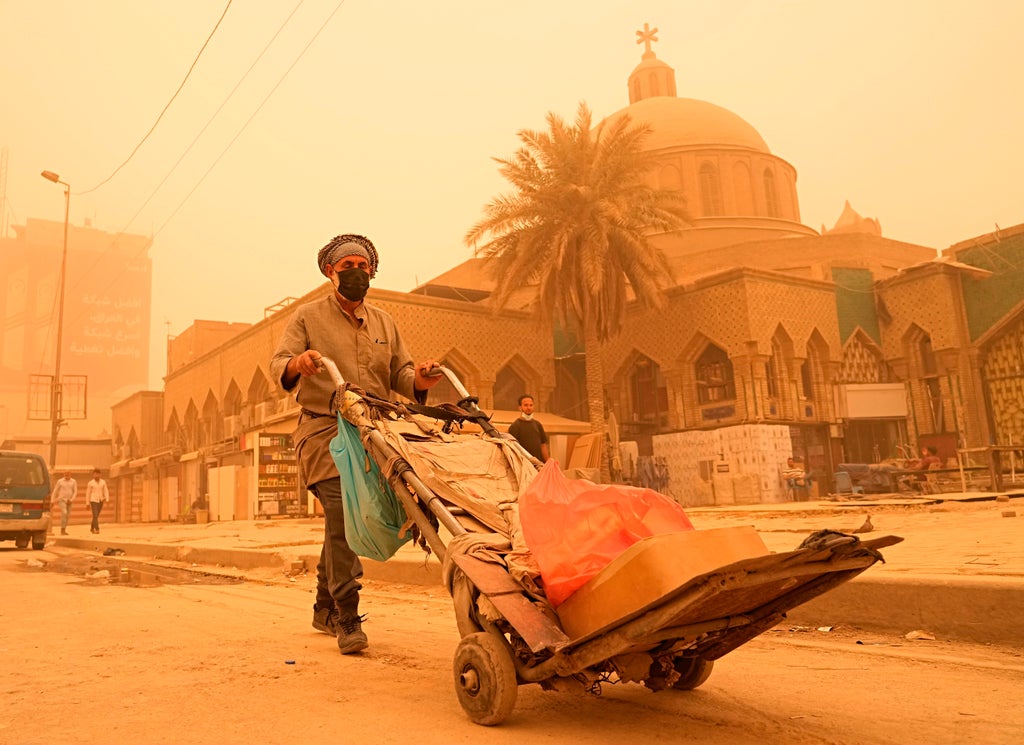
The thick layer of dust blanketing the sky did not deter Muhammed Ghalib from walking to work in Baghdad’s main commercial district on Monday, as the latest in an unrelenting series of intense sandstorms swept Iraq.
The dust coated his eyelashes a shade of orange. He arrived at 4 a.m., the height of the storm, and sat outside his stall by the street to sell household goods in the capital’s Shorja market. “Life goes on,” he said.
Ghalib was among the merchants in the capital who did not heed public warnings Monday to stay indoors because of poor weather conditions, lamenting financial losses and hardship amid ongoing economic woes.
There have been at least eight sandstorms in Iraq since April, according to officials. They have landed thousands of Iraqis in hospitals with severe breathing difficulties and at least one person died, according to Iraq’s Health Ministry, which declared a state of emergency.
Monday's sandstorm killed two people in neighboring Syria’s eastern province of Deir el-Zour along the border with Iraq, according to official news agency SANA. The agency said hundreds of people were taken to hospitals after suffering breathing problems, adding that the dead were a father and his son in Deir el-Zour.
Sham FM radio reported that a young man suffocated in the village of Al-Harijia north of Deir el-Zour.
Dust storms are a seasonal occurrence in Iraq but their frequency this year has alarmed experts who blame drought, rapid desertification and climate change.
On Monday, Baghdad Gov. Mohammed Jaber al-Atta suspended working hours in the province, with all departments excluding the Health Ministry temporarily closed. The provinces of Wasit, Diwaniyah and Babil also declared Monday a public holiday owing to the severity of the dust storm.
In the last major sandstorm on May 5, one person died in Iraq and 5,000 people were admitted to hospitals, the Health Ministry said. Ministry spokesman Saif al-Badr said Monday that Iraq’s medical facilities were on alert.
Flights were suspended at Baghdad, Najaf and Sulaimaniyah airports due to low visibility.
Climate activists have blamed inaction by the Iraqi government and poor water management policies for the increase in sandstorms. The phenomenon is expected to become more frequent amid record-low rainfall and rising summer temperatures.
Abu Dalal, a cashier at a restaurant in the Karada neighborhood of Baghdad, blamed the government for not prioritizing green spaces around the capital to capture the seasonal dust waves.
Essa Fayadh, a senior Environment Ministry official, said the government struggles to address desertification across vast swathes of agricultural land due to declining water reserves, which are down 50% from last year. The Iraqi government has blamed dam projects in Turkey and Iran for limiting river flows into Iraq.
“For this reason we could only divert water to irrigate 50% of agricultural lands this year,” he told The Associated Press, enabling the remainder to become drier and susceptible to sandstorms. “We had to prioritize food security with the resources we have,” he said.
In the capital, Iraqis are learning to adapt under a sepia sky. Many on the street wore surgical masks. “We have no choice,” Ghalib said, beating the dust from the dish cloths hanging outside his stall. A few minutes later, he does it again.
Nearby, Ahmed Saddi lamented the dwindling business. “There is no one, and that hurts (us) a lot.”
But customers still lined up outside Abid Sultan’s restaurant along Rasheed Street. Munching on rice dishes, his patrons joked the dust was extra seasoning.
The dust covered the fruits being sold across vegetable markets. Sajed Hamed, an employee in one, wiped apples and apricots with tissue.
“People still have to eat,” he said.






